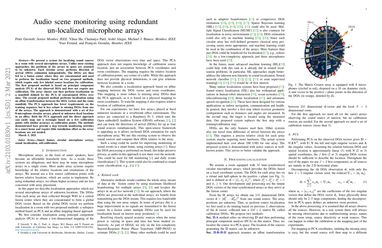Audio scene monitoring using redundant ad-hoc microphone array networks
We present a system for localizing sound sources in a room with several ad-hoc microphone arrays. Each circular array performs direction of arrival (DOA) estimation independently using commercial software. The DOAs are fed to a fusion center, concatenated, and used to perform the localization based on two proposed methods, which require only few labeled source locations (anchor points) for training. The first proposed method is based on principal component analysis (PCA) of the observed DOA and does not require any knowledge of anchor points. The array cluster can then perform localization on a manifold defined by the PCA of concatenated DOAs over time. The second proposed method performs localization using an affine transformation between the DOA vectors and the room manifold. The PCA has fewer requirements on the training sequence, but is less robust to missing DOAs from one of the arrays. The methods are demonstrated with five IoT 8-microphone circular arrays, placed at unspecified fixed locations in an office. Both the PCA and the affine method can easily map out a rectangle based on a few anchor points with similar accuracy. The proposed methods provide a step towards monitoring activities in a smart home and require little installation effort as the array locations are not needed.
PDF Abstract